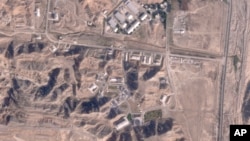Recent attempts by Iran to establish deterrence through direct strikes on Israel have mainly failed, according to analysts, leaving the Islamic Republic more vulnerable to its prime foe.
Israel’s recent retaliatory airstrikes on Iran are said to have dismantled all of Iran’s S-300 defense missile system. The strikes came in response to Iran's October 1 ballistic missile attacks against Israel. Iran says it is still assessing damage from the strikes.
Nicholas Heras of the Washington-based New Lines Institute for Strategy and Policy told VOA that the airstrikes showed Israel has “the qualitative military edge when it comes to war with Iran,” impacting the Muslim nation’s deterrence strategy.
“They struck advanced S-300 anti-air systems — which allowed them to evade Iranian air defenses and sites that are important for building vehicles for intercontinental ballistic missiles as well as the fuel for ballistic missiles, which is a key component of Iran’s deterrent strategy,” Heras said.
“They fundamentally wanted to send a signal to the Iranians that the Iranians are far behind the Israelis when it comes to the tech war,” he said.
Writing in the online Diwan publication, Nicole Grajewski, a Carnegie Endowment for International Peace fellow in its nuclear program, said, “Iran’s attempts to deter Israel through direct attacks have proven counterproductive, instead revealing gaps in its own defenses that Israel is increasingly willing to target … [and] likely places Iran in an even more precarious position than before October 1.”
Thomas Newdick, writing in The War Zone, agreed. “Putting the Iranian S-300s out of action leaves the door open to follow-up strikes by Israel, including larger scale direct attacks.”
This, he said, “serves as both a contingent opportunity for the Israel Defense Forces and a deterrent against a response from Iran.”
“It is almost inevitable that Israel has several follow-up options already planned should Iran respond with another barrage,” Newdick said.
Another component of Iran’s deterrent strategy has been the development of relationships over the years with Syria as well as regional militant groups, including those in Iraq, Hamas in Gaza, Yemen’s Houthi rebels and Lebanon’s Hezbollah. Israel assassinated Hamas and Hezbollah leaders, chief among them Yahya Sinwar and Hassan Nasrallah.
Analyst Steven Simon of Washington’s Quincy Institute, during an online presentation, said there are many unknowns about Iran’s “axis of resistance.” Simon questioned “how much is left of this axis of resistance for advancing Iran’s objectives, let alone their own.”
“Hamas is destroyed, basically, as a military organization,” Simon said. “Hezbollah has been very badly wounded. They took a serious beating: the pager attacks, the assassination of Nasrallah and [Hezbollah official Hashem] Safieddine, and others in their hierarchy.
“I don’t know how accurate the latest Israeli assessments are of the destruction they’ve inflicted on Hezbollah’s missile and rockets inventories,” he said, but “they are now saying that 80% of those rockets and missiles have either been expended or destroyed in Israeli airstrikes.”
Simon added that Hezbollah will find it difficult to replenish its Iranian arms supplies because Syria, as a conduit, is incapable of ensuring weapons can cross its borders into Lebanon.
Carnegie’s Grajewski said she believes Iran’s response options are now “severely constrained,” given the weakening of its proxy network and now that its own “missile arsenal proved both limited in scope and questionable in its reliability.”












